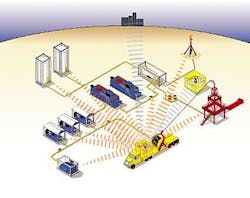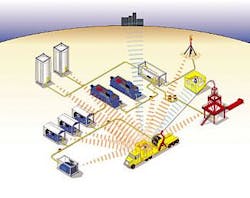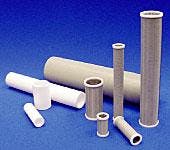Acquisition system transmits wellsite data wirelessly
DAQ>W, a new data acquisition system, is capable of transmitting data wirelessly from the wellsite.
The system consists of a network of sensors, each of which is connected to a battery-powered transmitter that is ATEX-certified for use in Zone 0 hazardous areas. As data measurements are acquired by the sensors, they are transmitted at regular intervals to the control cabin base station.Readings are then immediately displayed via custom software on the base station.
Internal batteries power transmitter boxes that can last as long as 10 years, and the base units can be powered by any 9-36 v DC supply, so it even runs efficiently from a car battery.Not only does the system improve work site safety standards, the DAQ>W is a much more reliable system, the company says.
Drilling engineers need never worry about losing data acquisition capabilities caused by damage to power cables, the firm points out.
The DAQ>W comes equipped with as many as 64 ATEX-certified sensors per base station, which means that they can be placed in any hazardous area.The system may be configured to operate a range of sensors for nearly any application, including CT drilling and workover or wireline operations.
null
For example, sensors that record data on temperature, flow or pulse, level, load-strain, pressure, or pump strokes are available.
Because the system operates wirelessly, it is possible to make the data it acquires available for viewing simultaneously in two or more locations.By default, the sensor signals are transmitted 500 m to the base station.
The base station can then relay the data to other base stations at distances of either 1 km or 10 km. This allows the receiving station and DAQ>W software to be placed in any convenient location, whether it is on a platform, moving car, or vessel.For engineers, it means that operations can be monitored well away from the wellsite.
Source: AnTech Ltd., Unit 7, Newbery Centre, Airport Business Park, Exeter, UK EX5 2UL.
Tubulars discussed in free brochure
DUOLINE 20 corrosion resistant oil field tubulars for seawater injection and disposal of salt water or other environmentally degrading corrosive fluids are described in a new brochure, yours free for the asking.
The company says its tubulars have demonstrated proved performance in corrosive gas and fluid injection for offshore and land-based applications. DUOLINE 20 is a durable glass-reinforced-epoxy liner that can be installed in carbon steel.
Liners can be installed in tubing or casing terminated with either standard or premium connections.
Source: Duoline Technologies LP, 9019 N. Co. Rd. West, Odessa, TX 79764.
Stainless steel filter elements are recleanable
Here are new high strength 316L stainless steel elements that are suited for use in heavily contaminated gases, liquids, polymers, steam, and stack gas applications. They are recleanable.
The elements' five layers offer surface area and depth area for removing solids and dropping out liquids.
The rigid durable construction provides precise pore size distribution, flow permeability, and lower initial pressure drop.
The company says the SS elements are flawless for applications where disposable elements cannot be used because of media migration, temperature constraints, and the inability to handle extreme differential pressure.
The firm's stainless mesh elements perform in all these environments.
Efficiency ranges from 0.5 micron to as much as 200 micron (standard). The SS elements fit UFS, Headline, as well as other proprietary brands.
Source: United Filtration Systems Inc., 6558 Diplomat Drive, Sterling Heights, MI 48314.


